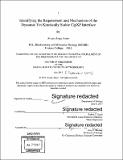Identifying the requirement and mechanism of the dynamic yet kinetically stable ClpXP interface
Author(s)
Amor, Alvaro Jorge
DownloadFull printable version (8.722Mb)
Other Contributors
Massachusetts Institute of Technology. Department of Biology.
Advisor
Robert T. Sauer.
Terms of use
Metadata
Show full item recordAbstract
AAA+ (ATPases Associated with various cellular Activities) proteases carry out regulated degradation and protein quality control. To achieve these goals, a barrel-shaped peptidase, with active sites in a sequestered chamber, cooperates with an attached AAA+ hexamer that recognizes, unfolds and translocates the protein substrate into the degradation chamber. The interaction between the AAA+ hexamer and peptidase must be specific and stable enough to ensure efficient degradation. However, information about the assembly of these proteases is limited. The subject of this thesis is the AAA+ ClpXP protease from Escherichia coli. ClpX is a AAA+ hexamer, and ClpP is a self-compartmentalized peptidase. Previous experiments have shown that ATP is required for assembly of active ClpXP complexes. Moreover, the IGF loops of ClpX are known to be important for stabilizing assembly. In Chapter 2, I use bio-layer interferometry (BLI) to determine the rates of ClpXP assembly and disassembly under different nucleotide conditions. ATP or ATP[gamma]S, a slowly hydrolyzed derivative, must occupy at least a subset of ClpX subunits allow ClpP binding. Moreover, I find that ClpX can only dissociate from ClpP once bound ATP is hydrolyzed to ADP and inorganic phosphate. As long as ClpX is ATP-bound, the ClpXP complex remains kinetically stable for more than three hours. However, even in the presence of ATP, the complex dissociates rapidly when ADEP, a small-molecule mimic of the IGF loop, is added. These results imply that the ClpXP interface is highly dynamic, with individual IGF-loops constantly unbinding and rebinding ClpP. In Chapter 3, I probe why ATP is important for ClpP binding and interrogate the importance of the sequence, length, and number of IGF-loops in ClpP binding. I found that ATP/ATP[gamma]S does not change the exposure of the IGF-loops but rather their proximity. At least four loops are required for stable binding, the length of the IGF loop is important, and residues in addition to the actual IGF sequence also play a role in complex stability. Finally, I discovered that a full complement of IGF loops is important both to allow rapid degradation and for degradation processivity because mutants with less than six loops do not appear to fully open the ClpP pore.
Description
Thesis: Ph. D., Massachusetts Institute of Technology, Department of Biology, 2017. Cataloged from PDF version of thesis. Includes bibliographical references.
Date issued
2017Department
Massachusetts Institute of Technology. Department of BiologyPublisher
Massachusetts Institute of Technology
Keywords
Biology.